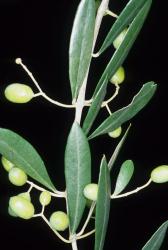- Taxon
- Gallery
Dense bushy shrub or small tree to c. 7 m high; bark becoming rough. Shoots angular, lepidote when young. Lvs shortly petiolate. Lamina 5–11 × 0.8–2 cm (juvenile lvs smaller), lanceolate or narrow-elliptic, sparsely to densely lepidote beneath and appearing pale green or slightly silvery, dark green and lepidote or elepidote above; base attenuate; apex mucronate. Panicles axillary. Calyx 1–1.5 mm long; lobes broad-triangular, glabrous or somewhat lepidote. Corolla lobes 3–4 mm long, whitish, ± oblong, almost fleshy, patent at first, ultimately reflexed. Stamens slightly < corolla. Drupe 5–8 mm diam., globose to broad-ovoid, glossy, becoming red and ultimately black.
[From: Webb et al. (1988) Flora of New Zealand. Volume 4.]
| Category | Number |
|---|---|
| Exotic: Fully Naturalised | 2 |
| Total | 2 |
Flowering: Jul.–Mar.




